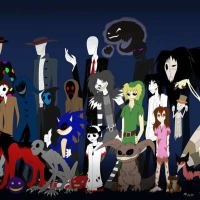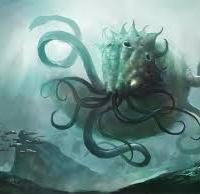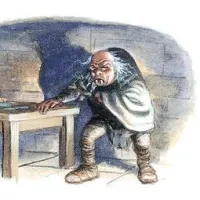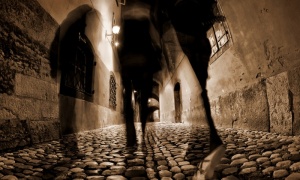A doppelgänger is a mysterious, exact double of a living person. It’s a German word that literally translates to “double walker” or “double goer”. A doppelganger isn’t someone who just resembles you, but is an exact double, right down to the way you walk, act, talk, and dress. A friend or even a close relative who encounters your doppelganger will swear it was you, even though you can prove you were not in the location the double was sighted. Although the word doppelgänger is often used in a more general and neutral sense, and in slang, to describe any person who physically resembles another person, in German folklore it is used to described a wraith or apparition of a living person, as distinguished from a ghost. The concept of the existence of a spirit double, an exact but usually invisible replica of every man, bird, or beast, is an ancient and widespread belief. To meet one’s double is a sign that one’s death is imminent. The doppelgänger became a popular symbol of horror literature, and the theme took on considerable complexity. In The Double (1846), by Fyodor Dostoyevsky, for example, a poor clerk, Golyadkin, driven to madness by poverty and unrequited love, beholds his own wraith, who succeeds in everything at which Golyadkin has failed. Finally the wraith succeeds in disposing of his original. An earlier, well-known story of a doppelgänger appears in the 1815 novel The Devil’s Elixir, by the German writer of fantastic tales E.T.A. Hoffmann. In fiction and mythology, a doppelgänger is often portrayed as a ghostly or paranormal phenomenon and usually seen as a harbinger of bad luck. Other traditions and stories equate a doppelgänger with an evil twin. In modern times, the term twin stranger is occasionally used.
Mystery of the Mothman
20 Jun
Perhaps the most widely known and talked about modern American myth is that of the Mothman, a creature first documented in the late 1960s. Since then, the Mothman has been spotted countless times in the United States. Some say it’s a harbinger of cataclysmic events. Others say it’s an alien life form with connections to UFOs and Men in Black. Many thing it has a more practical explanation, is a hoax, or is the product of mass hysteria. Whatever the case, the Mothman continues to pop up in real life and pop culture and is one of the more intriguing examples of modern American folklore – something where a quick Google search can’t dissuage its origins; something that permeates the minds of the people inflicted and the communities that branch off of them; a thing that lingers and re-manifests, jostling memories of the first time it crept from the depths of nowhere and made itself known. As legend has it, on November 12, 1966, in Clendenin, West Virginia, a group of gravediggers working in a cemetery spotted something strange. They glanced up from their work as something huge soared over their heads. It was a massive figure that was moving rapidly from tree to tree. The gravediggers would later describe this figure as a “brown human being.” This was the first reported sighting of what would come to be known as the Mothman, an elusive creature that remains as mysterious as it was on the night that a few frightened witnesses first laid eyes on it. The Point Pleasant Mothman is a local legend that over the years has gained worldwide fame. Author John Keel popularized local folklore about the creature with his 1975 book The Mothman Prophecies. The book was later adapted into a 2002 feature film with the same title, starring Richard Gere. Some believe The Mothman is a bad omen , only appearing when catastrophe is about to strike. Whether the pictures are real or not, the benefits the legend of the Mothman brings to the town of Point Pleasant, it would seem, are very real.
The Hollow Earth Theory
18 Apr
The Hollow Earth is a concept proposing that the planet Earth is entirely hollow or contains a substantial interior space. In recent decades, the idea has become a staple of the science fiction and adventure genres across films, most recently in Warner Bros’ MonsterVerse movies. Godzilla vs King Kong for example is loosely based on a real-life idea that dates back hundreds of years. Ancient civilizations had myths about an entire world that exists underground, hidden from the eyes of humans. In the 18th century, there were scientists who firmly believed in a ‘Hollow Earth’ theory, which postulated that the planet was actually hollow, and that there’s a massive, empty space under the surface. In most versions of the legend there are people or creatures living within it. This can vary depending on the theory or story, but Hollow Earth tales generally feature an entirely subterranean culture and community miles underneath the surface of our home planet. It’s not just fictional, though. There are people who claim our true Earth is hollow too. Some of those proponents even claim that there is a secondary sun within our planet, fueling those who live within the Hollow Earth. While it might seem utterly wild, it has as a theory at times been supported by famed scientists like Edmund Halley – who potentially came up with the idea – while also becoming a staple of science fiction storytelling as well as a popular conspiracy theory.
The Curse of La Llorona
19 Jan
La Llorona is a legendary figure with various incarnations. Usually translated into English as ‘the wailing woman’, she is often presented as a banshee-type: an apparition of a woman dressed in white, often found by lakes or rivers, sometimes at crossroads, who cries into the night for her lost children, whom she has killed. The infanticide is sometimes carried out with a knife or dagger, but very often the children have been drowned. Her crime is usually committed in a fit of madness after having found out about an unfaithful lover or husband who leaves her to marry a woman of higher status. After realising what she has done, she usually kills herself. She is often described as a lost soul, doomed to wander the earth forever. To some she is a bogeywoman, used by parents to scare children into good behaviour. This folk story has been represented artistically in various guises: in film, animation, art, poetry, theatre and in literature aimed at both adults and children alike. The legend is deeply ingrained in Mexican culture and among the Chicano Mexican population of the United States. The legend of La Llorona has supposedly haunted Mexico since before the Conquest. Her story is one of violence, much like the country whose suffering she is often taken to represent. So beware the woman in white…
The Black Dahlia
24 Nov
On the morning of January 15, 1947, Betty Bersinger was pushing her 3-year-old daughter Anne in a stroller down the sidewalk, heading to a shoe repair shop. She paused when she noticed what she thought was a mannequin lying in the grass. But as she looked closer, she discovered it was something much more alarming: a mutilated corpse. Bersinger grabbed Anne and ran to a nearby house, where she used the telephone to call the police. Authorities arrived on the scene just a few minutes later, kick-starting what would become a years-long investigation (that many people are still trying to solve). The naked body Bersinger discovered was in horrifying condition. In addition to being cut completely in half at the waist, and having her intestines removed, Short’s mouth had been slashed from ear-to-ear, giving her face a ghastly, semi-smiling appearance known as a Glasgow Smile. Her body had also been washed clean before it was left to be found. Despite the severe mutilation, there was no blood at the scene, leading police to conclude that the young woman had been murdered somewhere else, drained of blood, then cleaned before the killer dumped her body. The young woman turned out to be a 22-year-old Hollywood hopeful named Elizabeth Short—later dubbed the “Black Dahlia” by the press for her rumoured penchant for sheer black clothes and for the Blue Dahlia movie out at that time.Who killed the Black Dahlia and why? It’s a mystery. The murderer has never been found, and given how much time has passed, probably never will be. The legend grows…
The Grandfather Paradox
26 May
Time-travel has long been a staple of genre films, novels and television shows serving as everything from a backdrop to teen-comedy hi-jinks in Back to Future to thoughtful contemplation in Ray Bradbury’s short story A Sound of Thunder. Perhaps the craziest of the time travel paradoxes was cooked up by Robert Heinlein in his classic short story All You Zombies. But in the ‘real world’ time travel is thought to be impossible. The world-famous late physicist Professor Sir Stephen Hawking famously once threw a party at the University of Cambridge which was, he said, “a welcome reception for future time travellers,” a tongue-in-cheek reference his 1992 conjecture that travel into the past is effectively an impossibility. The ‘grandfather paradox’ outlines both philosopher’s and physicist’s main objection to time-travel: the possible violation of causality. The term for this comes from the paradox’s common description: a person travels to the past and kills their own grandfather before the conception of their father or mother, which prevents the time traveller’s existence. Whilst time-travel itself remains in the realm of pure speculation, the possible results of the violation of the principle of causality and how nature may prevent them, are hotly debated topics beyond the realms of pulp-fiction with philosophers and physicists speculating on possible solutions.
What became of the Bunyip?
24 Mar
Australia is famous for its huge swathes of untouched wilderness and for the unique, often deadly animals that wander there. You wouldn’t expect that a nation with the likes of the platypus and the killer box jellyfish would need to invent a new creature to add to its allure, yet reports of a mysterious, massive creature lurking in the waters of Australia abound. This creature, the Bunyip, is as much a part of Australian culture as any of its other fantastic beasts. The Bunyip (translated in Aboriginal Australian to mean devil or evil spirit), also known as the Kianpraty, is a creature of Aboriginal mythology. It lives in swamps, billabongs, creeks, riverbeds and waterholes all over Australia. The Bunyip has many descriptions. Some say it has a dog-like face, dark fur, a horse-like tail, flippers, walrus-like tusks, and a duck-like bill. Others think the creature has an appearance similar to a snake with a man and a beard. Some even think that the Bunyip is actually the prehistoric marsupial, Diprotodon australis, that managed to escape extinction. But the figure of the Bunyip was part of traditional Aboriginal beliefs and stories throughout Australia, while its name varied according to tribal nomenclature. In his 2001 book, writer Robert Holden identified at least nine regional variations of the creature known as the Bunyip across Aboriginal Australia. Europeans recorded various written accounts of Bunyips in the early and mid-19th century, as they began to settle across the country.
The Mandela Effect
18 Nov
The Mandela Effect refers to a phenomenon in which a large number of people share false memories of past events, referred to as confabulation in psychiatry. Some have speculated that the memories are caused by parallel universes spilling into our own, while others explain the phenomenon as a failure of collective memory. This form of collective misremembering of common events or details first emerged in 2010, when countless people on the internet falsely remembered Nelson Mandela was dead. It was widely believed he had died in prison during the 1980s. In reality, Mandela was actually freed in 1990 and passed away in 2013 – despite some people’s claims they remember clips of his funeral on TV. Self-described ‘paranormal consultant’ Fiona Broome coined the term ‘Mandela Effect’ to explain this collective misremembering, and then other examples started popping up all over the internet. If you have ever been convinced that something is a particular way only to discover you’ve remembered it all wrong, then it sounds like you may have experienced this phenomenon.
Jersey Ghosts
21 Jan
Eerie goings on abound on the island of Jersey. Despite being the largest of the Channel Island archipelago and having a slew of interesting and creepy tales its legends don’t seem to be written about as much as other places in the British Isles, which is a shame given that it is just as rich in myth and superstition as anywhere on mainland Britain. Aside from the more well-known stories that follow, a great deal of personal experiences are also reported by ordinary island folk: from strange lights to full-blown apparitions. Certainly, folklore and tales of the supernatural have always been integral to this island and the yarns that emanate from here range widely, featuring everything from fairies and witches to ghosts and giants. Most famously, on the north coast of Jersey tales used to spread of the Black Dog of Bouley Bay, a terrifying beast with huge teeth and eyes the size of saucers that roamed the coastline. The tales were probably invented by smugglers hoping to scare away parishioners from the coast while they landed their cargoes of brandy and tobacco but there are plenty of other tall tales told throughout the Channel Islands – of cursed wreckers, devil’s footprints, ghostly children and wailing grey ladies.
Krampus: The Devil of Christmas
17 Dec
Krampus is the dark companion of St. Nicholas, the traditional European winter gift-bringer who rewards good children each year on December 6. The kindly old Saint leaves the task of punishing bad children to a hell-bound counterpart known by many names across the continent — Knecht Ruprecht, Certa, Perchten, Black Peter, Schmutzli, Pelznickel, Klaubauf, and Krampus. Usually seen as a classic devil with horns, cloven hooves and monstrous tongue, but can also be spotted as a sinister gentleman dressed in black, or a hairy man-beast, Krampus punishes the naughty children, swatting them with switches and rusty chains before dragging them, in baskets, to a fiery place below. Krampus himself historically comes around the night of December 5, tagging along with St. Nicholas. He visits houses all night with his saintly pal. While St. Nick is on hand to put sweets and other goodies in the shoes of good children and birch twigs in the shoes of the bad, Krampus’ particular specialty is punishing naughty children. Legend has it that throughout the Christmas season, misbehaved kids are beaten with birch branches or can disappear, stuffed into Krampus’ sack and hauled off to his lair to be tortured or eaten. Krampus is celebrated on Krampusnacht, which takes place on the eve of St. Nicholas’ Day. In Austria, Northern Italy and other parts of Europe, party-goers masquerade as devils, wild-men, and witches to participate in Krampuslauf (Krampus Run). Intoxicated and bearing torches, costumed devils caper and carouse through the streets terrifying child and adult alike. Krampusnacht is increasingly being celebrated in other parts of Europe such as Finland and France, as well as in many American cities.

















